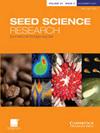Thermal requirements and germination niche breadth of Polygonum ferrugineum Wedd. from southeastern Brazil
IF 2.1
3区 生物学
Q2 PLANT SCIENCES
引用次数: 0
Abstract
Abstract Temperature may regulate seed dormancy and germination and determine the geographical distribution of species. The present study investigated the thermal limits for seed germination of Polygonum ferrugineum (Polygonaceae), an aquatic emergent herb distributed throughout tropical and subtropical America. Seed germination responses to light and temperature were evaluated both before (control) and after stratification at 10, 15 and 20°C for 7, 14 and 28 d. Germination of control seeds was ~50% at 10 and 15°C, and they did not germinate from 20 to 30°C. The best stratification treatment was 7 d at 10°C, where seed germination was >76% in the dark for all temperatures, except at 30°C, and < 60% in light conditions. A thermal time approach was applied to the seed germination results. Base temperature (Tb) was 6.3°C for non-dormant seeds and optimal temperature (To) was 20.6°C, ceiling temperature (Tc (<50)) was 32.8°C, and thermal time requirement for 50% germination was 44.4°Cd. We concluded that a fraction of P. ferrugineum seeds is dormant, has a narrow thermal niche to germinate (10 and 15°C) and that cold stratification (10°C) alleviated dormancy and amplified the thermal range permissive for germination of the species. Consequently, P. ferrugineum is expected to occur in colder environments, for example, at high altitudes. Higher temperatures decrease the probabilities of alleviate dormancy and the ability of their seeds to germinate.铁蓼的热需求和萌发生态位宽度。来自巴西东南部
摘要温度可以调节种子的休眠和发芽,并决定物种的地理分布。本研究调查了分布于热带和亚热带美洲的水生新兴草本植物铁精(Polygonum ferrogineum,Polygonaceae)种子发芽的温度极限。在10、15和20°C分层7、14和28 d之前(对照)和之后,评估种子对光和温度的发芽反应。对照种子在10和15°C下的发芽率约为50%,在20至30°C时不发芽。最佳分层处理是在10°C下7天,除30°C外,所有温度下种子在黑暗中发芽率>76%,在光照条件下发芽率<60%。将热时间法应用于种子发芽结果。非休眠种子的基本温度(Tb)为6.3°C,最适温度(To)为20.6°C,最高温度(Tc(<50))为32.8°C,50%发芽所需的热时间为44.4°Cd,具有狭窄的发芽热生态位(10和15°C),冷分层(10°C)缓解了休眠,并扩大了物种发芽的热范围。因此,铁精假单胞菌预计会出现在较冷的环境中,例如高海拔地区。更高的温度降低了缓解休眠的可能性和种子发芽的能力。
本文章由计算机程序翻译,如有差异,请以英文原文为准。
求助全文
约1分钟内获得全文
求助全文
来源期刊

Seed Science Research
生物-植物科学
CiteScore
3.60
自引率
4.80%
发文量
23
审稿时长
>12 weeks
期刊介绍:
Seed Science Research, the official journal of the International Society for Seed Science, is a leading international journal featuring high-quality original papers and review articles on the fundamental aspects of seed science, reviewed by internationally distinguished editors. The emphasis is on the physiology, biochemistry, molecular biology and ecology of seeds.
 求助内容:
求助内容: 应助结果提醒方式:
应助结果提醒方式:


